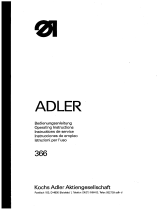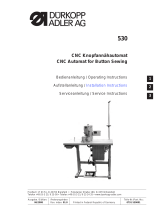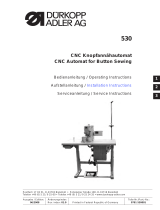Page is loading ...

Manual, complete
745 - 34 - 2
Sewing unit for runstitching of piped flap
and welt pocket openings and pocket corners
Working methods: A, B, D, F
Operating Instructions
Installation Instructions
Service Instructions
Instructions for Programming DAC
Postfach 17 03 51, D-33703 Bielefeld • Potsdamer Straße 190, D-33719 Bielefeld
Telefon + 49 (0) 5 21 / 9 25-00 • Telefax + 49 (0) 5 21 / 9 25 24 35 • www.duerkopp-adler.com
1
2
3
4
Ausgabe / Edition: Änderungsindex Teile-Nr./Part.-No.:
08/2007 Rev. index: 01.0 Printed in Federal Republic of Germany 0791 745181

745 - 34 - 2
Manual, complete
Contents
Operating Instructions
Installation Ins tructions
Service Instructions
Instructions for Programming DAC
Interconnection-diagram
9870 745154 B
9890 745002 B
Pneumatic circuit plan
9770 745005
All rights reserved.
Property of Dürkopp Adler AG and copyrighted. Reproduction or publication of the content in
any manner, even in extracts, without prior written permission of Dürkopp Adler AG, is
prohibited.
Copyright ©
Dürkopp Adler AG - 2007

Foreword
This instruction manual is intended to help the user to become familiar
with the machine and take advantage of its application possibilities in
accordance with the recommendations.
The instruction manual contains important information on how to
operate the machine securely, properly and economically. Observation
of the instructions eliminates danger, reduces costs for repair and
down-times, and increases the reliability and life of the machine.
The instruction manual is intended to complement existing national
accident prevention and environment protection regulations.
The instruction manual must always be available at the machine/sewing
unit.
The instruction manual must be read and applied by any person that is
authorized to work on the machine/sewing unit. This means:
– Operation, including equipping, troubleshooting during the work
cycle, removing of fabric waste,
– Service (maintenance, inspection, repair) and/or
– Transport.
The user also has to assure that only authorized personnel work on the
machine.
The user is obliged to check the machine at least once per shift for
apparent damages and to immediatly report any changes (including the
performance in service), which impair the safety.
The user company must ensure that the machine is only operated in
perfect working order.
Never remove or disable any safety devices.
If safety devices need to be removed for equipping, repairing or
maintaining, the safety devices must be remounted directly after
completion of the maintenance and repair work.
Unauthorized modification of the machine rules out liability of the
manufacturer for damage resulting from this.
Observe all safety and danger recommendations on the machine/unit!
The yellow-and-black striped surfaces designate permanend danger
areas, eg danger of squashing, cutting, shearing or collision.
Besides the recommendations in this instruction manual also observe
the general safety and accident prevention regulations!

General safety instructions
The non-observance of the following safety instructions can cause
bodily injuries or damages to the machine.
1. The machine must only be commissioned in full knowledge of the
instruction book and operated by persons with appropriate training.
2. Before putting into service also read the safety rules and
instructions of the motor supplier.
3. The machine must be used only for the purpose intended. Use of
the machine without the safety devices is not permitted. Observe all
the relevant safety regulations.
4. When gauge parts are exchanged (e.g. needle, presser foot, needle
plate, feed dog and bobbin) when threading, when the workplace is
left, and during service work, the machine must be disconnected
from the mains by switching off the master switch or disconnecting
the mains plug.
5. Daily servicing work must be carried out only by appropriately
trained persons.
6. Repairs, conversion and special maintenance work must only be
carried out by technicians or persons with appropriate training.
7. For service or repair work on pneumatic systems, disconnect the
machine from the compressed air supply system (max. 7-10 bar).
Before disconnecting, reduce the pressure of the maintenance unit.
Exceptions to this are only adjustments and functions checks made
by appropriately trained technicians.
8. Work on the electrical equipment must be carried out only by
electricians or appropriately trained persons.
9. Work on parts and systems under electric current is not permitted,
except as specified in regulations DIN VDE 0105.
10. Conversion or changes to the machine must be authorized by us
and made only in adherence to all safety regulations.
11. For repairs, only replacement parts approved by us must be used.
12. Commissioning of the sewing head is prohibited until such time as
the entire sewing unit is found to comply with EC directives.
13. The line cord should be equipped with a country-specific mains
plug. This work must be carried out by appropriately trained
technicians (see paragraph 8).
It is absolutely necessary to respect the safety
instructions marked by these signs.
Danger of bodily injuries !
Please note also the general safety instructions.

Index Page:
Part 2: Installation Instructions 745-34-2
1. Scope of delivery .............................................. 3
2. General notes ................................................ 3
3. Installing the sew ing unit
3.1 Transport.................................................... 4
3.2 Removingthesecuritydevices....................................... 5
3.3 Settingtheworkingheight ......................................... 6
3.4 Adjusting the foot pedals .......................................... 7
4. Attaching the machine parts removed for shipping
4.1 Threadreelholder.............................................. 8
4.2 Cylinder for pick-up folder stroke ..................................... 9
4.3 Workpieceboxes............................................... 10
4.4 Fastening the holder for control panel, bobbin winder and right-hand tray............. 11
4.5 Table extension (optional equipment)................................... 12
4.5.1 Table extension for working method with bundle clamp carriage................... 12
4.5.2 Tableextensionforstackingtotheside ................................. 13
4.6 Throw-over stacker (optional equipment) ................................ 14
5. Electrical connection
5.1 Connecting the control panel DAC III ................................... 16
5.2 Connecting the external bobbin winder.................................. 16
5.3 Checking the nominal voltage and connecting to the mains ..................... 17
5.4 Checking the nominal voltage of the vacuum device (optional equipment) ............ 20
5.5 Directionofrotationofthesewingmotorandthevacuumblower ................. 20
6. Pneumatic connection........................................... 21
7. Connection to the factory-ow n vacuum unit ............................. 22
8. Oil lubrication ................................................ 23
9. Commissioning ............................................... 24
10. Installing the sew ing softw are
10.1 General..................................................... 24
10.2 Loading the program............................................. 25
10.3 Dongle-Update via the Internet ...................................... 26
2


2
1. Scope of delivery
–
Basic sewing unit for runstitching of piped, flap and welt pocket
openings with rectangular and slanted pocket corners, consisting
of:
–
Height-adjustable stand
–
Step motors for sewing drive, material feed, length adjustment
of the corner incision device
–
Twin needle lockstitch machine
–
DAC III control with control panel
–
Laser marking lamps
–
Sewing light
–
Compressed air maintenance unit with compressed air pistol
–
Thread reel holder
–
Workpiece boxes for additional parts to the left of the operator
and underneath the table top
–
Tools and small parts in the accessories
–
Feeding and sewing equipment according to the working
method
–
Optional equipment
2. General notes
ATTENTION !
The sewing unit must only be assembled by trained specialist staff.
Any work on the electrical equipment of the sewing unit must
only be carried out by electricians or correspondingly instructed
persons.
The mains plug must be pulled out.
The enclosed operating instructions of the step motor manufacturer
have to be observed in any case.
3

4
3. Installing the sewing unit
3.1 Transport
For in-house transport the stand is equipped with four castors.
ATTENTION !
Do not lift the sewing unit at the table tops.
Use an elevating platform truck or a forklift truck.
ATTENTION!
Before commissioning the sewing unit screw out the stand
feet 2 and 3 until a secure footing is achieved.
Lifting the sew ing unit
–
Push the elevating platform truck or the fork lift forks into the
openings 1 at the back of the sewing unit.
Rolling the sew ing unit
–
For transport purpose unfasten the stand feet 2 and 3 by turning
them to the right.
–
After transport secure the sewing unit by turning the stand feet 2
and3totheleft.
321

3.2 Removing the securing devices
Before installing the sewing unit all six securing devices have to be
removed.
If the sewing unit has to be transported to another place, please use
the securing devices again.
5
2

3.3 Setting the working height
The working height can be set between 79 cm and 110 cm
(measured up to the upper edge of the table top).
The sewing unit is set to the lowest w orking height of 79 cm by the
manufacturer.
ATTENTION: Danger of breakage !
When loosening the securing screws.
The sewing unit may overturn when the tubular feet of the frame are
pulled out.
Set the height of the sewing unit by pulling equally the tubular feet of
the frame.
–
Loosen the nut 1 (4x) and the shoulder bolts 2 (4x) (clamping of the
front tubular foot).
–
Loosen screws 3 (4x) (clamping of the rear tubular foot).
–
Set the table top to the desired height to be flush.
–
To avoid a tilting, pull out / push in the tubular feet uniformly on
both side.
–
Tighten the shoulder bolts 2 and the screws 3.
–
If you want to set the foot pedal afterwards, please do not tighten
the nut 1 yet. Otherwise it can also be tightened.
6
12
3

3.4 Adjusting the foot pedals
The height of the foot pedals can also be set, independently of the
height of the sewing unit.
The angle of slope and the lateral position of the foot pedals are also
adjustable.
Setting the height
–
Loosen nut 1 and shift both guides 2 in the slotted hole.
Loosen the screws 3 additionally, in order to displace them in the
next slotted hole.
Make sure to have the same height in both guides 2.
–
Tighten the nut 1.
Setting the angle of slope
–
Unscrew the screw 4 and swivel the pedal.
–
Adjust the angle of slope of the pedal.
–
Tighten the screws 3 (2x) and screw 4 with the pedal at the desired
position.
Setting the lateral position
–
Loosen the screws 5 and shift the pedal laterally.
–
Tighten screws 5 again.
7
2
1 243
43 5

4. Attaching the machine parts removed for shipping
4.1 Thread reel holder
–
Insert the thread reel holder 2 in the drill-hole of the table top
and fasten it with nut 4 underneath the table top.
–
Mount and align the reel plate 1 and the unwinding arms 3 as
shown in the illustration.
8
321
4

4.2 Cylinder for pick-up folder stroke (745-34-2 B/F)
–
Remove the securing device and swivel the cylinder upwards.
–
Fasten the cylinder fixture 1 to plate 3 with screws 4 .
–
Move the fixture for the pick-up folder by hand.
The movement must be fingertip easy over the whole cylinder
stroke.
Correction
–
Loosen screws 3 a little and move the fixture for the pick-up folder
over the whole cylinder stroke.
In the course of this the cylinder fixture aligns itself.
–
Tighten screws 3.
–
Check the free movement once again.
9
2
32 1

4.3 Workpiece boxes
–
Fasten the workpiece boxes onto rod 2.
For this purpose push the clamping pieces 4 and 3 on rod 2, align
the height and clamp them firmly by tightening the screws.
–
Loosen the screw at clamping lever 1 and align the workpiece
boxes to the sewing s tation.
–
Tighten the screw at clamping lever 1.
10
43 21

4.4 Fastening the holder for control panel, bobbin winder and right-hand tray
Control panel
–
Fasten angle 6 and control panel 5 to bolt 3 with nut 4.
–
Fasten cable 1 to bolt 3 with screw 2.
Bobbin w inder and tray
–
Push holder 11 with angle 10 onto the table top and tighten
with the scr ew.
–
Align the arms 9 and 12.
–
Fasten the tray 8 to the lower arm.
–
Fasten the bobbin winder 7 to the upper arm.
See chapter 5.2 for connecting the bobbin winder.
2
11
6 543 21
7 1210119 8

4.5 Table extensions (optional equipment)
4.5.1 Table extension for working method with bundle clamp carriage (Order No. 0745 597674)
–
Fasten the table extension 3 onto the table top brace with the
screws 2.
–
Loosen screws 1 slightly.
Create a clearance to the table top by shifting the table extension 3.
This clearance is required for the free passage of the positioned
pocket bag.
12
321

4.5.2 Table extension for stacking to the side (Order No. 0745 597684)
–
Fasten table extension 2 to the front of the rest table brace with the
screws 1.
–
Screw angle 3 on table top 4 with two screws.
2
13
21
53
45

4.6 Throw-over stacker (optional equipment)
The throw-over stacker 1 (Order No. 0745 597554) is fastened to the
stand of the s ewing unit with mounting pipe 2.
–
Fasten the mounting pipe 2 in the right stacking opening 4 with
screws, washers and shackle 3.
–
Push the throw-over stacker towards the stand of the sewing unit.
–
Fasten spars 5 and 6 on spar 2 with the shackle and the two
brackets 7.
–
Insert the coupling plug of the compressed air supply (thick hose)
into hose coupling 8.
–
Insert the coupling plug of the control conduit (thin hose) into
coupling 9.
14
78
325 4 1
46
10 9

Aligning the stacker
–
Shift the stacker laterally in such a way that spar 11 is flush with
the table top edge 13.
–
Loosen the clamping lever 14.
–
Move the stacker up on cylinder 15 so that the moving smoother 12
does not hit the table top.
–
Tighten the clamping lever 14.
2
15
15 14
12 11 13

5. Electrical connection
ATTENTION!
Any work on the electrical equipment of the sewing unit must
only be carried out by electricians or correspondingly instructed
persons.
The mains plug must be pulled out.
5.1 Connecting the control panel DACIII
–
Carefully insert plug 1 into the rear panel of the control panel.
–
Tighten the screws 2 of plug 1.
5.2 Connecting the external bobbin winder
–
Insert the plug of the bobbin winder into the socket 3 underneath
the table top and secure with a cap nut.
–
Connect the potential compensation cable 4.
16
21
3
4
/














